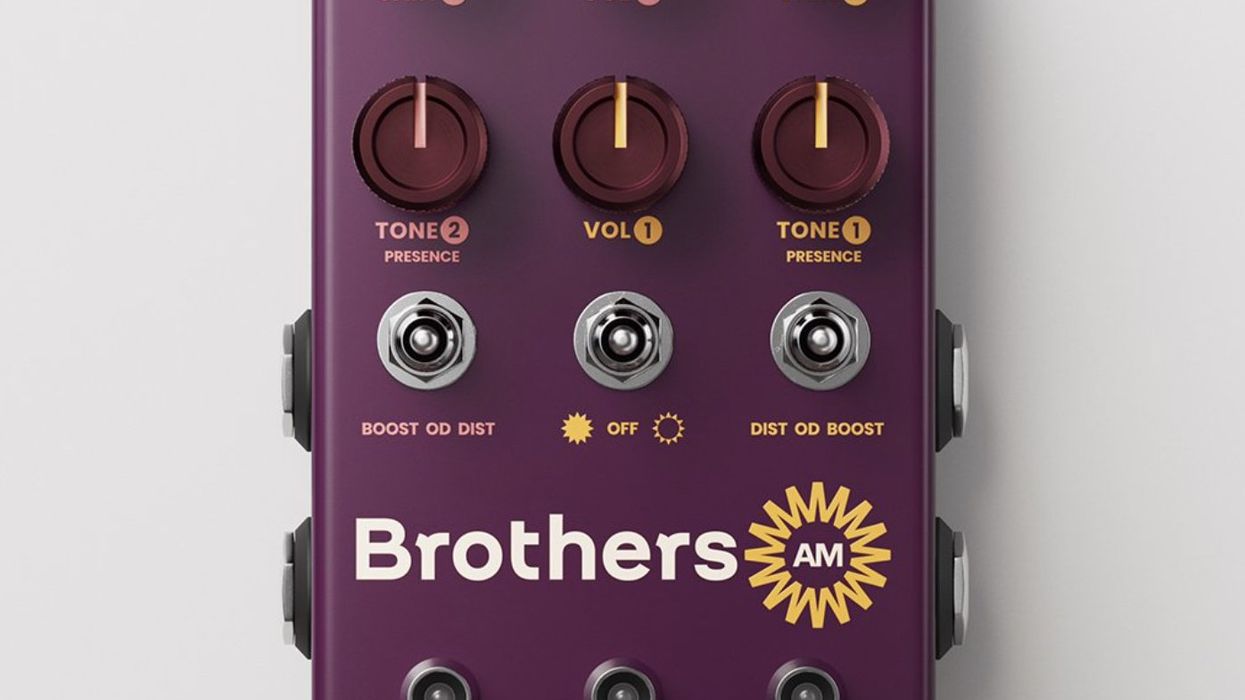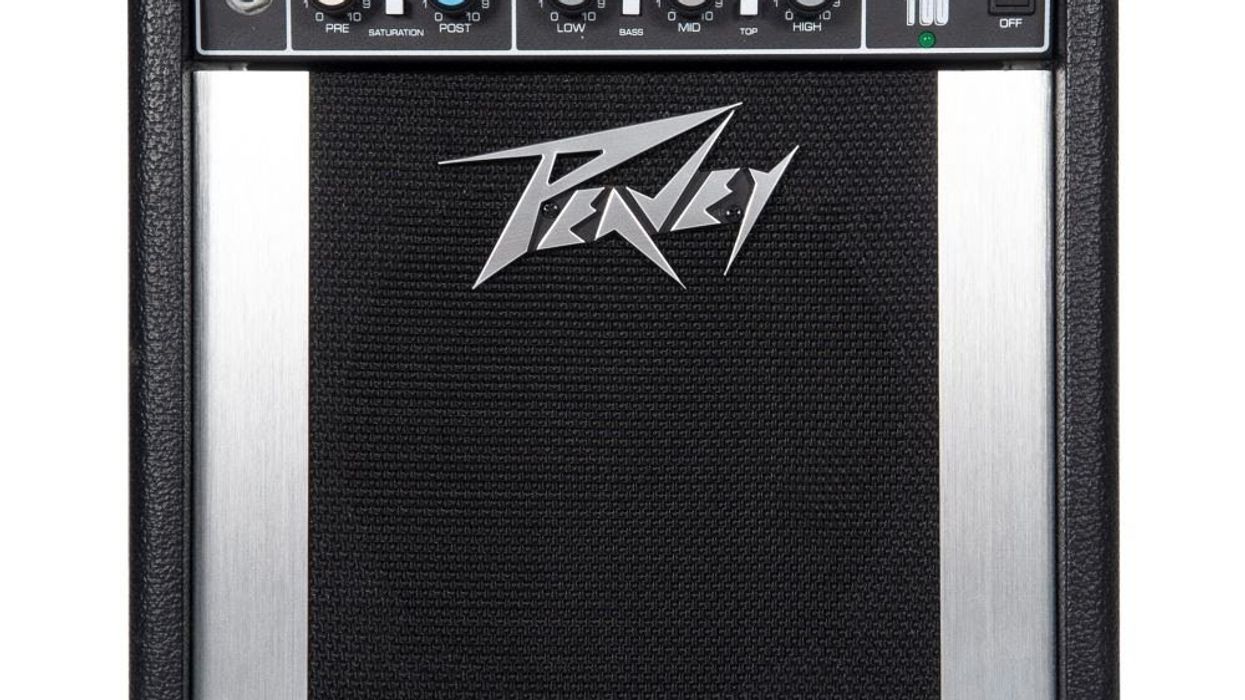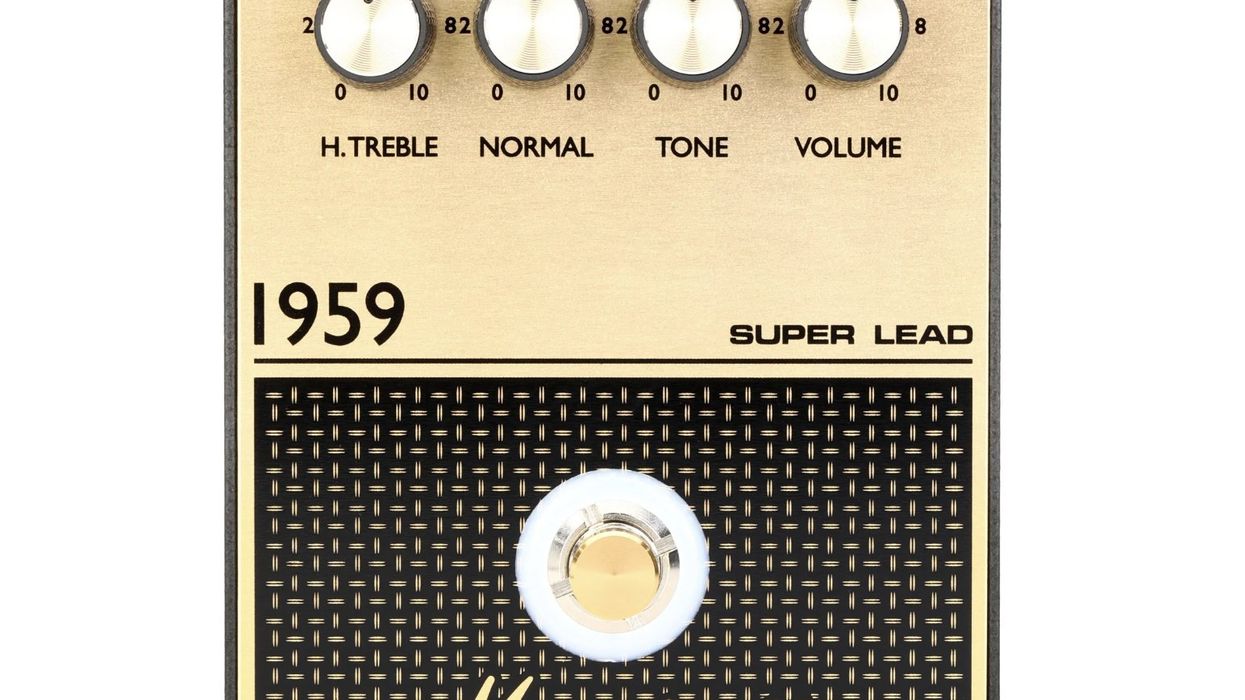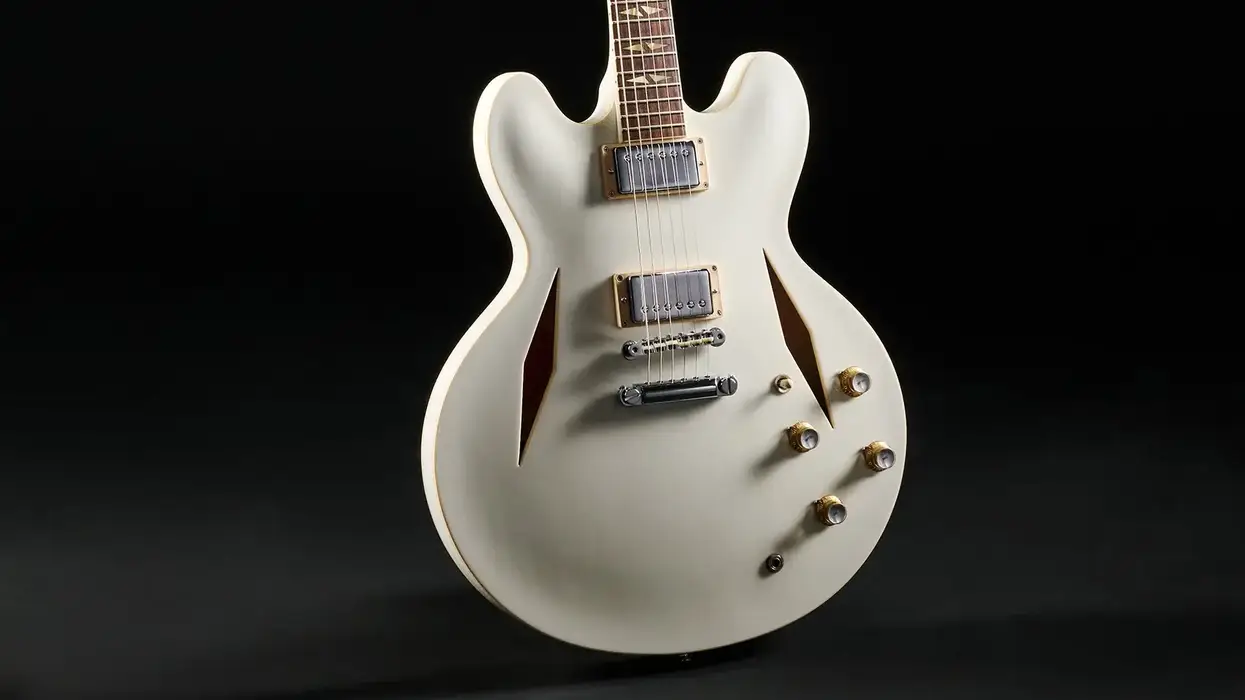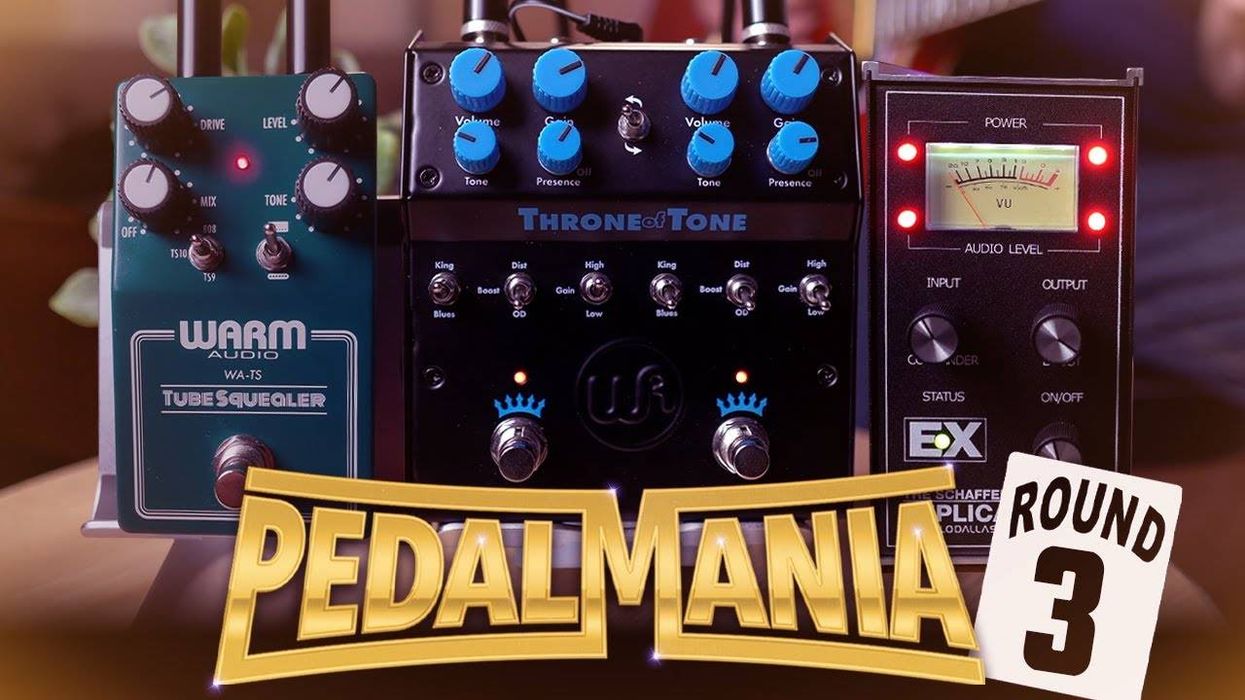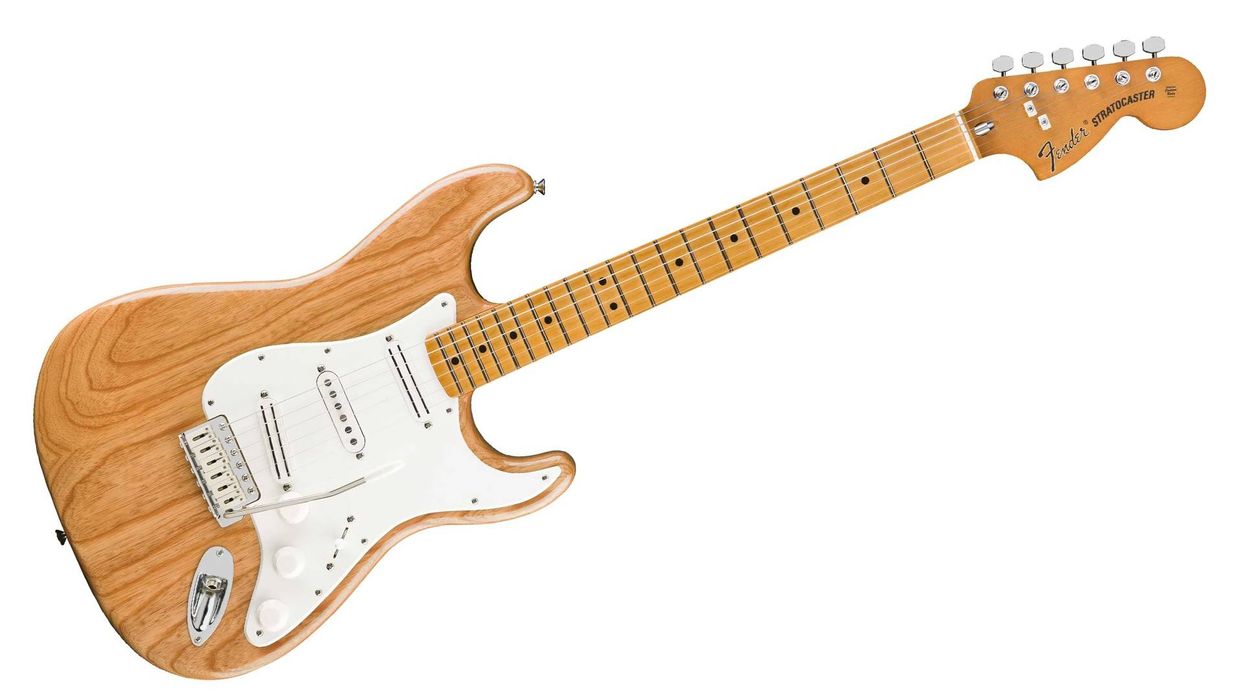Fingerpicking, or fingerstyle guitar as it’s
commonly called, is basically plucking
the strings with bare fingers, fingernails,
and on occasion, with the aid of picks. I
began fingerpicking early in my career and
after throwing away my fingerpicks—once
referred to by a colleague as my Freddy
Krueger Starter Set—I found myself playing
with more fluid movements and power. This
came along with the discovery of my ability
to create three-dimensional dynamic effects.
If you find yourself among the players who still lack a system for fingerpicking that prevents you from producing these sounds, perhaps your “fingerpicking engine” needs a tune-up. Is your tone production often weak? Do you use the same finger twice in a row to pluck the same string, creating not only a hiccup in the music, but also a tense feeling in your hands and the rest of your body? Then you have come to the right place.
As my students cultivate their own fingerpicking system, I try to convince them to first focus on themselves, then the music in front of them. I encourage them to tune into their breathing, their body postures, and any tension that might be building up in order to learn how to relax during the development of a piece or during an exercise. Only then, as they relax, can their entire attention be focused and devoted to learning. Even while they work extensively with a metronome at different speeds to develop a groove, I want them to remain calm and not stressed out.
Let’s get on to revving up your fingerpicking engine. Your transmission is made up of a basic language of picking patterns with a positional system used to create group landing points, and most importantly, a borrowing system that eliminates using the same picking finger twice in a row.
Don’t get me wrong. There are many times when I will use the same finger twice in a row, such as with a grouped finger vamp of sorts, frequently used in jazz, or if I am dealing with quarter- and eighth-notes where a finger substitution is not as urgent a requirement. But these moves are intentional, not accidental due to poor finger placement.
For a closer look at the language of the picking hand, visualize two different menus of choices, much like sitting down at your two favorite restaurants. One menu offers up arpeggio patterns, where a group of fingers pluck, following a single thumb strike. You can see an example of this with an Am chord in Fig. 1 and an E chord in Fig. 2. Just a reminder, for all these examples we are using the traditional p–i–m–a notation for the plucking hand where p is for the thumb, i is for index, m is for middle, and a is for the ring finger.
or download example audio

or download example audio

The other menu, which is slightly more expansive, consists of alternating bass patterns, including two types of rolls, pinch patterns, and pairings of fingers. In Fig. 3, we combine an inside roll with a forward roll. If you look at the first two beats of each measure, you can see how we pluck the 2nd and 5th strings before moving “inside” to hit the 4th and 3rd strings. In the second half of the measure we begin with the 5th and 3rd strings before moving “forward” onto the 4th and 2nd strings.
or download example audio

We begin to develop multiple patterns with multiple voices in Fig. 4. By using your m and a fingers for the melody, you are able to keep the upper voice ringing while p and i keep the accompaniment going. I call these “pinch” patterns because there is a pinching motion between your thumb and your middle or ring fingers. Fig. 5 is a variation on the forward roll, but here we add an additional note in order to practice moving our fingers in specific groupings.
or download example audio

or download example audio

Once we have some basic patterns down, we can move on to different string sets with a position-based system that will keep your fingers in an orderly arrangement. Using a simple E chord, I have demonstrated the three positions in Fig. 6. In the first measure, we use i–m–a on strings 3–1. Think of this as position 1. We move that group of fingers to strings 4–2 in the second measure for position 2, and finally we shift to strings 5–3 for position 3. Try some arpeggios with these positions and practice moving between them.
or download example audio

Let’s try some finger substitutions with the picking hand so you can begin to see when and where these opportunities arise. The most basic example I can think of, which appears in some fashion in nearly every tune I encounter, is shown in Fig. 7. Essentially, when you have two or more notes on the same string you can “borrow” a finger to help out. When I am moving from the 2nd string to the 1st string, I start with m–i and then use a on the 1st string. When going the other direction, I use m–a.
or download example audio

It’s that simple. This exercise should demonstrate that each finger can stay close to its home base. Just to test the theory, try plucking with the same finger twice in a row, pick up speed, and watch, or better yet, feel what happens. This method can be done with any chord, on any groups of strings, in any tuning, and with any style of music.
When learning a new piece, I often refer to my approach as tapping, clapping, and mapping. It’s a method of first tapping out the rhythms on a table using a metronome as my guide, then clapping the rhythm with my hands, and finally mapping out the intended choice of fingerings for both hands. Similar to programming a computer, my hands now seem to know what to do automatically. As you polish up your fingerpicking engine, always inspect each measure, one at a time, to make sure no details have been missed. That is what separates the good pickers from the great ones.
 Richard Gilewitz
Richard Gilewitz
Once touted as one of the strangest men in acoustic music, fingerstyle guitarist Richard Gilewitz lives up to this depiction with his rousing performances filled with amazing chops, humor, and a history of the acoustic guitar from blues to folk, traditional to classical, and all points in between. For more information, visit richardgilewitz.com.
If you find yourself among the players who still lack a system for fingerpicking that prevents you from producing these sounds, perhaps your “fingerpicking engine” needs a tune-up. Is your tone production often weak? Do you use the same finger twice in a row to pluck the same string, creating not only a hiccup in the music, but also a tense feeling in your hands and the rest of your body? Then you have come to the right place.
As my students cultivate their own fingerpicking system, I try to convince them to first focus on themselves, then the music in front of them. I encourage them to tune into their breathing, their body postures, and any tension that might be building up in order to learn how to relax during the development of a piece or during an exercise. Only then, as they relax, can their entire attention be focused and devoted to learning. Even while they work extensively with a metronome at different speeds to develop a groove, I want them to remain calm and not stressed out.
Let’s get on to revving up your fingerpicking engine. Your transmission is made up of a basic language of picking patterns with a positional system used to create group landing points, and most importantly, a borrowing system that eliminates using the same picking finger twice in a row.
Don’t get me wrong. There are many times when I will use the same finger twice in a row, such as with a grouped finger vamp of sorts, frequently used in jazz, or if I am dealing with quarter- and eighth-notes where a finger substitution is not as urgent a requirement. But these moves are intentional, not accidental due to poor finger placement.
For a closer look at the language of the picking hand, visualize two different menus of choices, much like sitting down at your two favorite restaurants. One menu offers up arpeggio patterns, where a group of fingers pluck, following a single thumb strike. You can see an example of this with an Am chord in Fig. 1 and an E chord in Fig. 2. Just a reminder, for all these examples we are using the traditional p–i–m–a notation for the plucking hand where p is for the thumb, i is for index, m is for middle, and a is for the ring finger.
or download example audio
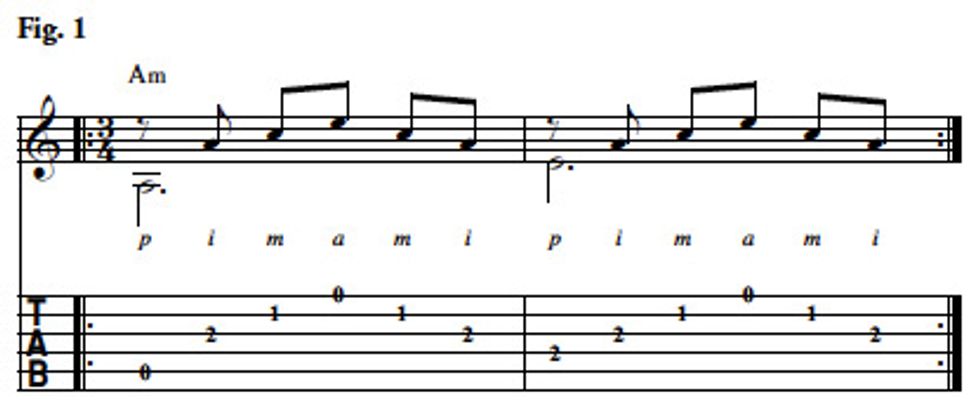
or download example audio
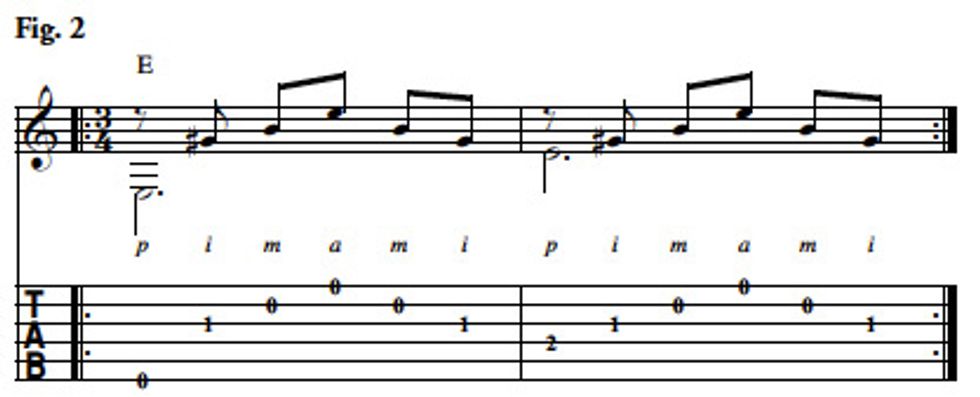
The other menu, which is slightly more expansive, consists of alternating bass patterns, including two types of rolls, pinch patterns, and pairings of fingers. In Fig. 3, we combine an inside roll with a forward roll. If you look at the first two beats of each measure, you can see how we pluck the 2nd and 5th strings before moving “inside” to hit the 4th and 3rd strings. In the second half of the measure we begin with the 5th and 3rd strings before moving “forward” onto the 4th and 2nd strings.
or download example audio
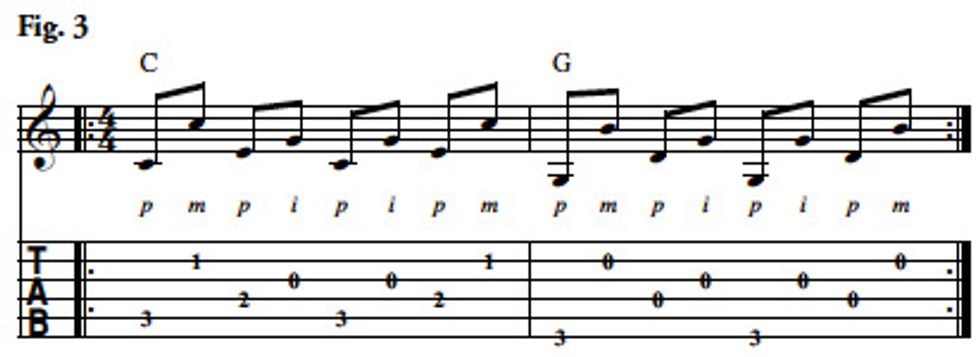
We begin to develop multiple patterns with multiple voices in Fig. 4. By using your m and a fingers for the melody, you are able to keep the upper voice ringing while p and i keep the accompaniment going. I call these “pinch” patterns because there is a pinching motion between your thumb and your middle or ring fingers. Fig. 5 is a variation on the forward roll, but here we add an additional note in order to practice moving our fingers in specific groupings.
or download example audio
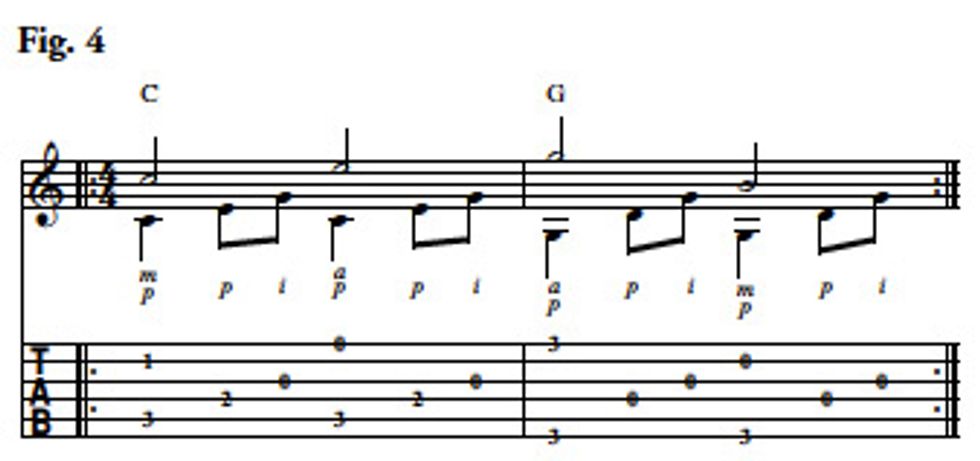
or download example audio
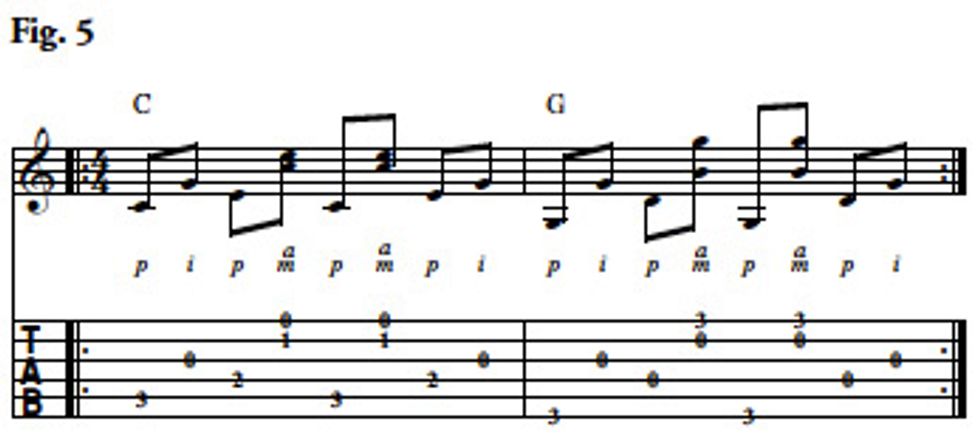
Once we have some basic patterns down, we can move on to different string sets with a position-based system that will keep your fingers in an orderly arrangement. Using a simple E chord, I have demonstrated the three positions in Fig. 6. In the first measure, we use i–m–a on strings 3–1. Think of this as position 1. We move that group of fingers to strings 4–2 in the second measure for position 2, and finally we shift to strings 5–3 for position 3. Try some arpeggios with these positions and practice moving between them.
or download example audio

Let’s try some finger substitutions with the picking hand so you can begin to see when and where these opportunities arise. The most basic example I can think of, which appears in some fashion in nearly every tune I encounter, is shown in Fig. 7. Essentially, when you have two or more notes on the same string you can “borrow” a finger to help out. When I am moving from the 2nd string to the 1st string, I start with m–i and then use a on the 1st string. When going the other direction, I use m–a.
or download example audio
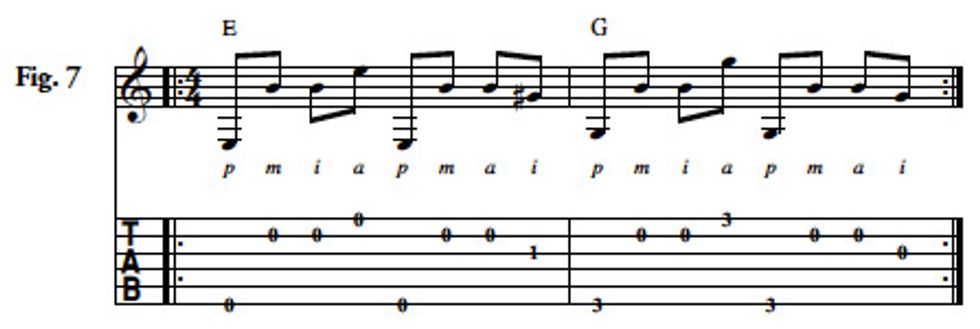
It’s that simple. This exercise should demonstrate that each finger can stay close to its home base. Just to test the theory, try plucking with the same finger twice in a row, pick up speed, and watch, or better yet, feel what happens. This method can be done with any chord, on any groups of strings, in any tuning, and with any style of music.
When learning a new piece, I often refer to my approach as tapping, clapping, and mapping. It’s a method of first tapping out the rhythms on a table using a metronome as my guide, then clapping the rhythm with my hands, and finally mapping out the intended choice of fingerings for both hands. Similar to programming a computer, my hands now seem to know what to do automatically. As you polish up your fingerpicking engine, always inspect each measure, one at a time, to make sure no details have been missed. That is what separates the good pickers from the great ones.
 Richard Gilewitz
Richard Gilewitz Once touted as one of the strangest men in acoustic music, fingerstyle guitarist Richard Gilewitz lives up to this depiction with his rousing performances filled with amazing chops, humor, and a history of the acoustic guitar from blues to folk, traditional to classical, and all points in between. For more information, visit richardgilewitz.com.

